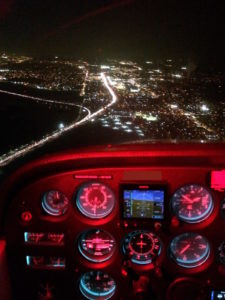Solo flight to Phoenix
November 28th, 2017 at 9:57 pm (Flying)
For Thanksgiving, I flew myself from L.A. to Phoenix. It’s about a 3.5-hour flight in a Cessna 172 – long enough to make for an interesting cross-country planning exercise and good practice for me solo!
I departed the El Monte airport at 11:17 a.m. with flight following to my destination, the Mesa Gateway airport (KIWA). Initially I got an altitude restriction of 2500′, which progressively stepped all the way up to my cruise altitude of 9500′.
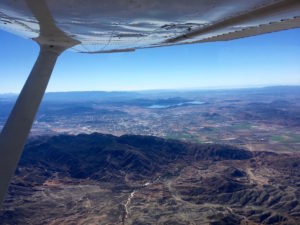
Looking south towards Diamond Valley Lake
The SoCal controller asked, “What is your route of flight to Williams?” Since I had gotten this question on my flight to the Grand Canyon, this time I was ready to answer!
“Palm Springs to Thermal to Blythe to Buckeye to… Gateway!” (i.e., not “Williams”)
“Oh yeah,” said the controller. “I forgot the name.” Later I learned that KIWA used to be called “Williams Gateway airport” which helps explain why this controller (and another one along the way) used the other name.
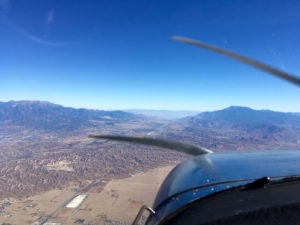
Approaching the Banning Pass
Near the Palm Springs VOR, I got a traffic warning for a jet passing by (“caution wake turbulence”). I looked out to the left and saw a jet climbing past, a healthy distance away. I reported the traffic in sight and was told to “maintain visual separation.” I watched it climb up and away from me (fast!) and decided it was okay.
I then spent a couple of hours droning my way east through the desert sky. I scanned my instruments. I updated my nav log. I drank some water. I played with the GPS (good time to explore new features ;) ). I fought off the hypnosis that comes from nothing happening in a fully trimmed plane and no adverse conditions and very little traffic on the radio.
Most of the desert looked like this:
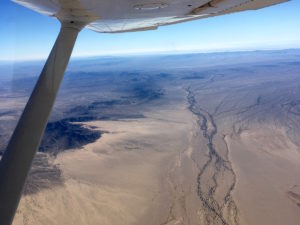
At Blythe, I crossed the Colorado river:
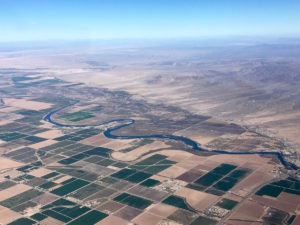
As I got close to Phoenix, things started to happen (and I got too busy to take pictures).
Luke Approach asked me, “When will you begin your descent, and to what altitude?”
“I was planning to descend at Buckeye, but I can start now, descending to 5500′, or a Bravo transition if possible?” (This would allow me to go more directly to KIWA, which is on the other side of Phoenix.)
He told me to stand by, then: “Descent approved, switch to Phoenix Approach, expect a Bravo transition.”
But my celebration was short-lived. I switched to the other frequency, which was suuuper busy. The controller gave me a right turn for traffic and told me to remain clear of the Bravo. I complied. I continued my descent and kept an eye on the mountains (alt 4600′) as I drew closer and closer (around 5500′).
Finally I said, “678 requests left turn to avoid terrain.”
Controller: “678, negative, maintain heading.”
This was rather vexing. I could of course go higher to clear the mountains with more margin. But just to the east of the mountains, the Phoenix Bravo airspace begins at 6000′. So if I got higher than that, I would have to be ready to dive under it, and that seemed like a bad set-up right over the mountains. I continued thinking about it and climbed up to 5900′.
Finally I got switched to new controller who was more accommodating (or less busy). I requested a direct turn to Gateway (I was still heading southeast thanks to the earlier controller!) and was approved. I soared over the mountains and carefully slid in under the Bravo airspace. I then had to continue stepping down to stay under it. I got traffic alerts a couple of times to help spice things up more. Then I had to cross over the Chandler airport’s airspace (goes up to 3000′) while staying under the Bravo (which goes down to 4000′ there). If you think this is stressful while you’re watching for other airplanes, navigating an unfamiliar area, and remembering to fly the plane (airspeed, engine status, throttle, enrich that mixture!, pre-landing checklist!), you’re right.
At last I got handed over to the KIWA tower. Home free! Except not. I got assigned a right base entry for runway 12R, which was exactly what I was anticipating given the winds. Then:
“678, converging traffic, same altitude, suggest you climb.”
Argh! I turned my descent into a climb (mindful of that 4000′ Bravo!). After a bit, the tower informed me that the traffic had passed behind me. He instructed me to “continue east, we’ll fit you into the right downwind.” This was kind of handy since by then I would have had to work pretty hard to get down to pattern altitude (2600′) before reaching the airport. But it was also tricky because I was then heading southeast and would need to set up for a northwest downwind prior to a right turn to 12R. This is easier to see with a picture:
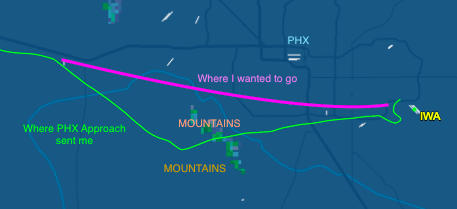 The green line is my radar track.
The green line is my radar track.I landed neatly just after the threshold for 12R… then had to roll a looooong way to get off at taxiway H. By that I mean something like 3000′ of putt-putt-putt down the runway. Next time I will land longer. These 10,000′ runways are huuuuuge for a little Cessna!
Maybe not so huge for these guys, who landed right after me:
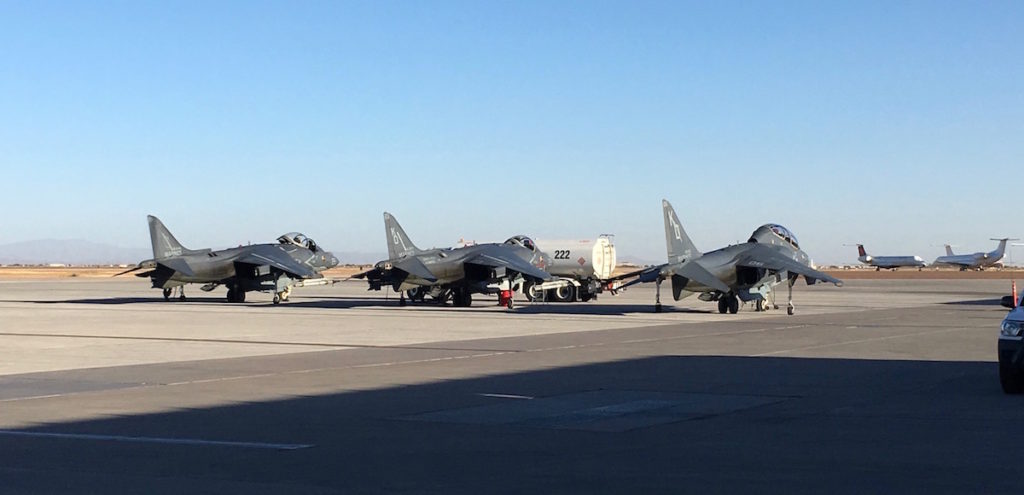
Great flight, all told!
